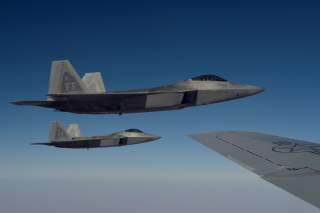China Claims It Can Detect Stealth Planes Like the F-22 Raptor
Do you believe them?
Key Point: Until it's used in combat, neither the Americans or the Chinese will really know if their anti-stealth radar works.
In addition, it also functions as a fire control radar that can guide missiles toward stealthy jets like the F-35.
“Meter wave radar can be deployed on vehicles, on land and warships, creating a dense web that gives hostile stealth aircraft nowhere to hide,” said China’s Global Times.
Chinese scientists say they have solved a fundamental dilemma inherent to radar. High-frequency radars, such as microwave radars, emit a lot of short pulses that are good for guiding weapons to a target. Low-frequency radars, that emit waves that are meters long, are better for searching an area but aren’t precise enough for fire control (here’s a quick primer). That means high- and low-frequency radars tend to be paired for search and fire control.
Stealth aircraft are shaped to avoid detection by high-frequency beams. “Meter wave radars can detect stealth aircraft because modern stealth aircraft are mainly designed to avoid detection by microwave radar, and are less stealthy to meter wave radar,” said Global Times. “However, analysts previously said that because of their low resolution and accuracy, meter wave radars can only send warnings about incoming threats. And even if microwave radars compensate for the shortcomings of the meter wave radars, they are unable to entirely overcome these shortcomings.”
Wu Jianqi, a senior scientist at the state-owned China Electronics Technology Group Corporation, told Chinese media that his team has solved this dilemma. “Wu solved the issue by designing the world's first practical meter wave sparse array synthetic impulse and aperture radar,” according to Global Times. “Wu said that his radar has multiple transmitting and receiving antennas tens of meters high, scattered in a range of tens to hundreds of meters. They can continuously cover the sky as the radar receives echoes from all directions.”
Wei Dongxu, a Chinese military analyst, told Global Times that “this significantly enhances the radar's ability to track an aerial target, pinpointing the stealth aircraft's exact coordinates by synthesizing parameters and data gathered by the radar under the support of advanced algorithms. Since the radar can now see stealth aircraft clearly and track them continuously and accurately, it could become capable of guiding long-range anti-aircraft missiles and landing precision strikes on them."
Wu also said that this development puts China ahead of other nations in developing anti-stealth radar. “As for now, I do not see a meter wave air defense radar from abroad that can match the criteria of the advanced meter wave radar.”
But is this true?
The vulnerability of stealth aircraft to low-frequency beams has not escaped the notice of military researchers around the world. Russia has also claimed – more than once – to have developed stealth-detecting radar. Naturally, the U.S. is also working on advanced sensors that will do the same.
While the physics of the Chinese claims seem plausible, it is important to remember that the effectiveness of a military sensor depends on a variety of factors. How easily can the Chinese meter-wave radar be spoofed or jammed? How vulnerable are these radar complexes – comprising multiple antennae – to being destroyed by missiles?
In the end, the problem with evaluating anti-stealth is the same as evaluating stealth: we really won’t know how well any of this work until it is used in combat. The F-35 has been used in minor conflicts like Syria, operating against second-string or non-existent air defenses. But stealth – or anti-stealth – will only be proven in a conflict between powers that possess advanced aircraft, radars and anti-aircraft missiles. That means America, Russia and China.
Michael Peck is a contributing writer for the National Interest. He can be found on Twitter and Facebook. This piece was originally featured in September 2019 and is being republished due to reader's interest.
Media: Reuters

